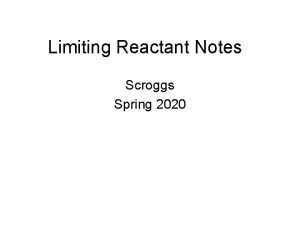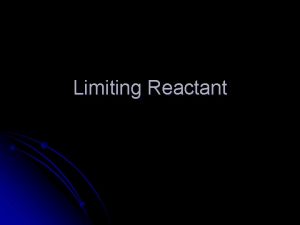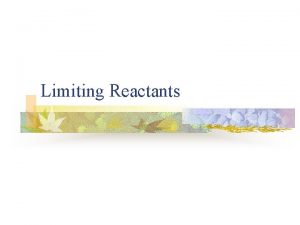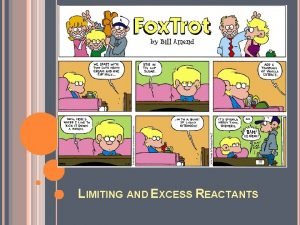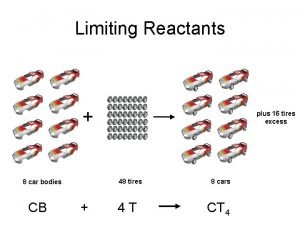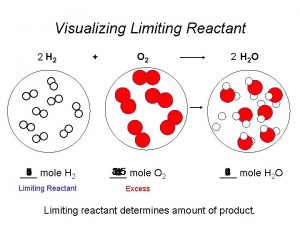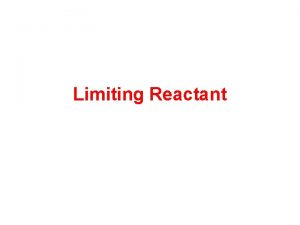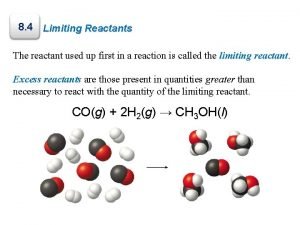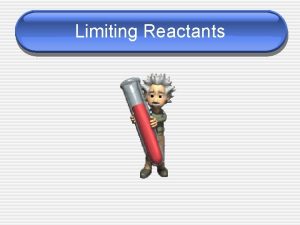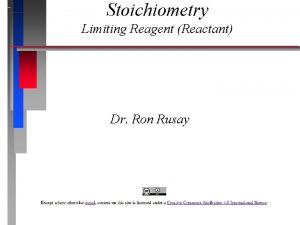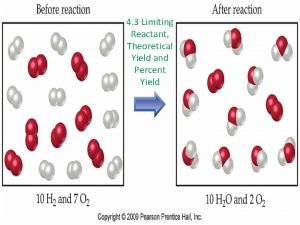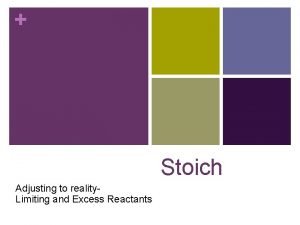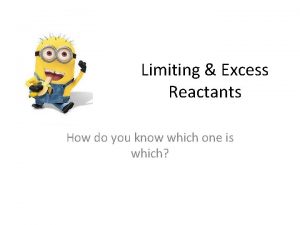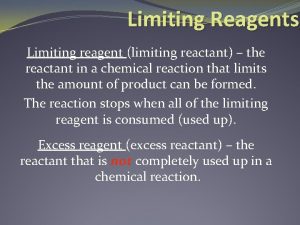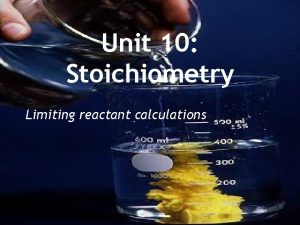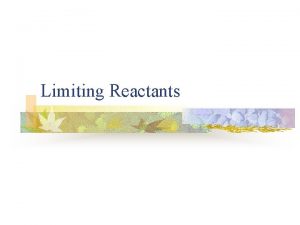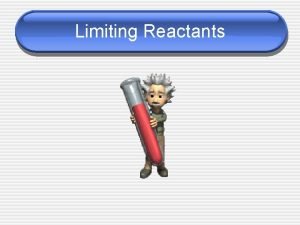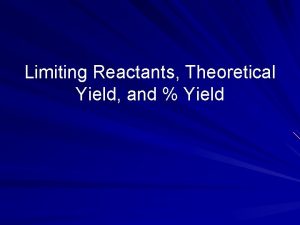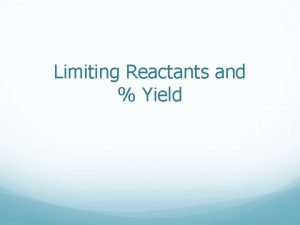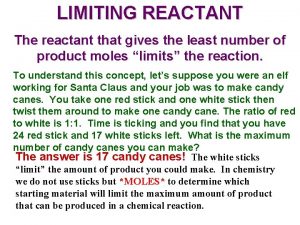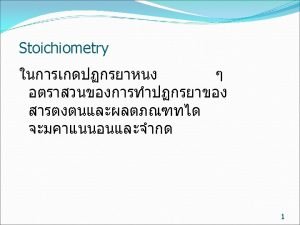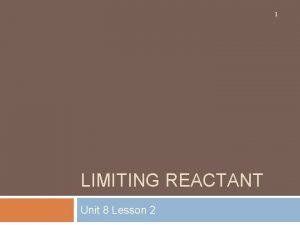LIMITING REACTANT q When 2 or more reactants






















- Slides: 22

LIMITING REACTANT q When 2 or more reactants are combined in nonstoichiometric ratios, the amount of product produced is limited by the reactant that is not in excess. q This reactant is referred to as limiting reactant. q When doing stoichiometric problems of this type, the limiting reactant must be determined first before proceeding with the calculations. 1

LIMITING REACTANT ANALOGY Consider the following recipe for a sundae: 2

LIMITING REACTANT ANALOGY The number How many sundaes of sundaes can possible be prepared is limited from by thethe followingofingredients: amount syrup, the limiting reactant. Limiting reactant Excess reactants 3

LIMITING REACTANT q When Compare solving yourlimiting answersreactant for eachproblems, assumption; the assumevalue lower eachisreactant the correct is limiting assumption. reactant, and Lower calculate the desired quantity based on that value is assumption. correct A+B C A is LR Calculate amount of C B is LR Calculate amount of C 4

Example 1: A fuel mixture used in the early days of rocketry was a mixture of N 2 H 4 and N 2 O 4, as shown below. How many grams of N 2 gas is produced when 100 g of N 2 H 4 and 200 g of N 2 O 4 are mixed? 2 N 2 H 4 (l) + 1 N 2 O 4 (l) 3 N 2 (g) + 4 H 2 O (g) Limiting reactant Mass-mass calculations 5

Example 1: 2 N 2 H 4 (l) + 1 N 2 O 4 (l) 3 N 2 (g) + 4 H 2 O (g) Assume N 2 H 4 is LR 100 g N 2 H 4 1 32. 04 3 2 4. 68 mol N 2 6

Example 1: 2 N 2 H 4 (l) + 1 N 2 O 4 (l) 3 N 2 (g) + 4 H 2 O (g) Assume N 2 O 4 is LR 200 g N 2 O 4 1 92. 00 3 1 6. 52 mol N 2 7

Example 1: 2 N 2 H 4 (l) + 1 N 2 O 4 (l) 3 N 2 (g) + 4 H 2 O (g) Assume N 2 H 4 is LR 4. 68 mol N 2 Assume N 2 O 4 is LR 6. 52 mol N 2 H 4 is LR Correct amount 8

Example 1: 2 N 2 H 4 (l) + 1 N 2 O 4 (l) 3 N 2 (g) + 4 H 2 O (g) Calculate mass of N 2 4. 68 mol N 2 28. 0 1 = 131 g N 2 9

Example 2: How many grams of Ag. Br can be produced when 50. 0 g of Mg. Br 2 is mixed with 100. 0 g of Ag. NO 3, as shown below: Mg. Br 2 + 2 Ag. NO 3 2 Ag. Br + Mg(NO 3)2 Limiting Reactant 10

Example 2: Mg. Br 2 + 2 Ag. NO 3 2 Ag. Br + Mg(NO 3)2 Assume Mg. Br 2 is LR 50. 0 g Mg. Br 2 1 184. 1 2 1 187. 8 1 102 g Ag. Br 11

Example 2: Mg. Br 2 + 2 Ag. NO 3 2 Ag. Br + Mg(NO 3)2 Assume Ag. NO 3 is LR 100. 0 g Ag. NO 3 1 169. 9 2 2 187. 8 1 111 g Ag. Br 12

Example 2: Mg. Br 2 + 2 Ag. NO 3 2 Ag. Br + Mg(NO 3)2 Assume Mg. Br 2 is LR 102 g Ag. Br Assume Ag. NO 3 is LR 111 g Ag. Br Mg. Br 2 is LR Correct amount 13

PERCENT YIELD q The amount of product calculated through stoichiometric ratios are the maximum amount product that can be produced during the reaction, and is thus called theoretical yield. q The actual yield of a product in a chemical reaction is the actual amount obtained from the reaction. 14

PERCENT YIELD q The percent yield of a reaction is obtained as follows: 15

Example 1: In an experiment forming ethanol, theoretical yield is 50. 0 g and the actual yield is 46. 8 g. What is the percent yield for this reaction? 92. 7 % 16

Example 2: Silicon carbide can be formed from the reaction of sand (Si. O 2) with carbon as shown below: 1 Si. O 2 (s) + 3 C (s) 1 Si. C (s) + 2 CO (g) When 100 g of sand are processed, 51. 4 g of Si. C is produced. What is the percent yield of Si. C in this reaction? Actual yield 17

Example 2: 1 Si. O 2 (s) + 3 C (s) 1 Si. C (s) + 2 CO (g) Calculate theoretical yield 100 g Si. O 2 1 60. 1 1 1 40. 1 1 66. 7 g Si. C 18

Example 2: Calculate percent yield 77. 1 % 19

Theoretical and Actual Yield • In order to determine theoretical yield, we use reaction stoichiometry to determine the amount of product each of our reactants could make. • The theoretical yield will always be the least possible amount of product. – The theoretical yield will always come from the limiting reactant. • Because of both controllable and uncontrollable factors, the actual yield of product will always be less than theoretical yield.

Chap. 8 terms you should know 1. Limiting reactant - the reactant that limits the amount of product produced in a chemical reaction. The reactant that makes the least amount of product. 2. Theoretical yield - the amount of product that can be made in a chemical reaction based on the amount of limiting reactant. 3. Actual yield - the amount of product actually produced by a chemical reaction. 4. Percent yield - The percent of theoretical yield that was actually obtained. actual yield % yield = theoretical yield x 100

THE END 22
 More more more i want more more more more we praise you
More more more i want more more more more we praise you More more more i want more more more more we praise you
More more more i want more more more more we praise you Limiting reagent vs limiting reactant
Limiting reagent vs limiting reactant Determine the limiting reagent
Determine the limiting reagent Reactants products and leftovers
Reactants products and leftovers Limiting reactant def
Limiting reactant def Limiting reactants in a recipe
Limiting reactants in a recipe Limiting and excess reactants formula
Limiting and excess reactants formula Limiting and excess reactants race car answers
Limiting and excess reactants race car answers Excess reagent def
Excess reagent def Reactant
Reactant Limiting reactants practice worksheet
Limiting reactants practice worksheet Limiting reactant definition
Limiting reactant definition Limiting reactant def
Limiting reactant def Limiting reactant def
Limiting reactant def Reactants def
Reactants def Reactant examples
Reactant examples Stoichiometry example
Stoichiometry example Percent yield
Percent yield Excess reagent def
Excess reagent def A limiting reactant is ______.
A limiting reactant is ______. What is a limiting reactant
What is a limiting reactant Banana split method limiting reagent
Banana split method limiting reagent


